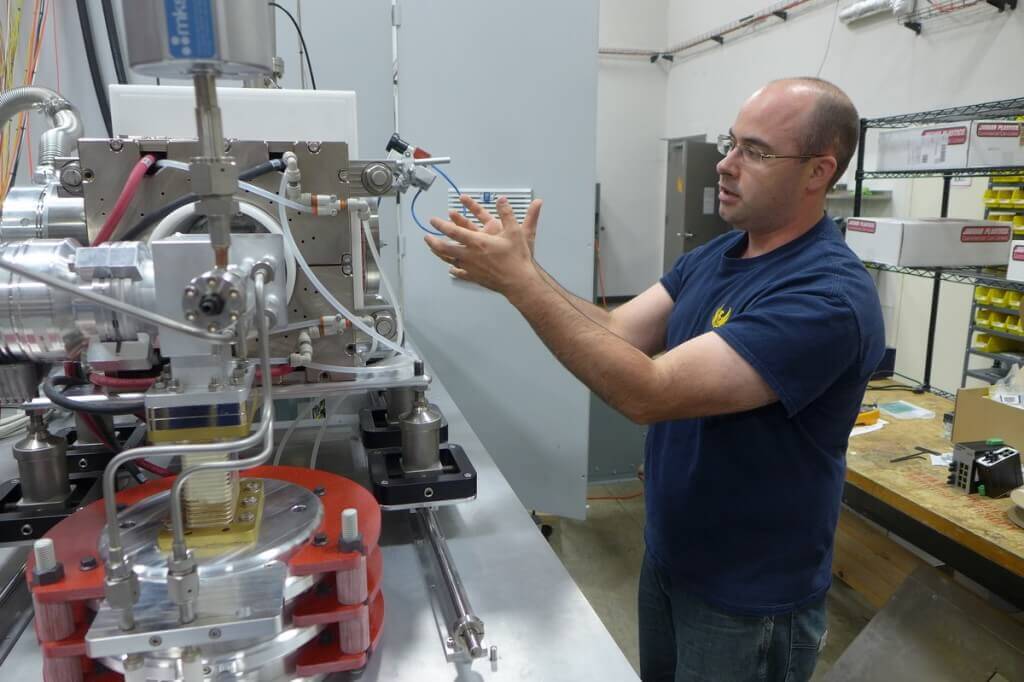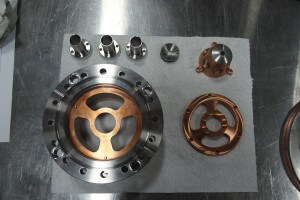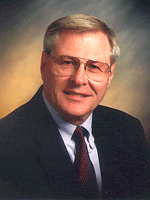Heavy-duty neutron accelerators paint promising future for UW-Madison spinoff

Ross Radel, president of Phoenix Nuclear Labs, explains a prototype of a negative hydrogen ion source. Developed with funding from the Department of Energy, this device has sparked interest in the semiconductor industry. Photo: David Tenenbaum
One of the world’s most powerful commercial neutron generators, made by a Madison manufacturer, is now being used to calibrate nuclear-reactor safety detectors in the United Kingdom.
Neutrons are the neutral particles in an atom. Reactor operators measure their level to protect worker health and ensure that the reactor is operating properly.
The powerful accelerator was built by Phoenix Nuclear Labs (PNL), a University of Wisconsin–Madison spinoff. Phoenix was started in Madison in 2005 by Greg Piefer, who received a Ph.D. in engineering physics from the university in 2006. The U.K. reactor represents the company’s first sale outside the research market.
The company’s device accelerates a hydrogen isotope against a target; the impact releases a stream of neutrons. The prototype accelerator may look like a prop for a campy, 1950s sci-fi film, but that strong beam of neutrons has many uses. For example, it can alter surface properties in solar-cell manufacturing or create an isotope needed in about 20 million medical diagnostic scans annually in the United States.

These components, part of Phoenix’s neutron generator, will extract ions so they can be accelerated to high velocity in an intense electric field. Photo courtesy: Phoenix Nuclear Labs
One PNL accelerator is being used to detect voids in artillery shell propellant, which can cause an explosion that would kill the gun crew. A reliable, powerful neutron generator allows scanning during manufacture, increasing troop safety.
“Over the past decade, PNL has grown from a custom R&D shop into an industry-leading manufacturer of state-of-the-art neutron-generation and particle-acceleration systems,” says Ross Radel, company president, who also holds a Ph.D. in engineering physics from UW–Madison.
Neutrons are released when atomic nuclei break apart in the process of nuclear fusion. Fusion powers most nuclear weapons and the sun.
On a much smaller scale, the Phoenix process creates a limited, controlled fusion reaction: Hydrogen ions are accelerated in a 300,000-volt electric field so they move fast enough to overcome the magnetic repulsion of a target nucleus, and initiate fusion.
The acceleration phase requires a vacuum, while the gaseous target must be dense or else the neutrons will pass right through. Because separating the two phases could block the neutrons, the process requires a clever means of controlling pressure that allows the neutrons to transit the apparatus.
That invention, which Piefer devised in 2005, is the key to the Phoenix accelerator. “I was really excited when I realized this could work,” he says. “But when I did a literature search, I found that (UW-Madison medical physicist) Paul DeLuca had done something similar in the ’70s.”
Finding the precedent “was a blessing and a curse,” Piefer says. “It said some of this was out there so we could not lock it all down with patents. But I didn’t have to prove to anyone that it worked.”
Piefer was granted a patent for his separation apparatus in 2014.
Fusion may be best known as the ideal energy source that has never delivered. Fusion produces neutrons and large amounts of energy, but no greenhouse gases and little or no radioactive waste — so it could be an ideal source of electricity. But that goal is still decades in the future.

Gerald Kulcinski
Piefer credits Gerald Kulcinski, a professor of engineering physics at UW–Madison, for sparking his interest in practical uses for fusion. “Jerry had this idea to use fusion to make money, at a level below energy, and he came up with a roadmap with multiple steps, culminating in fusion energy.”
“The university has been involved in more than 60 fusion reactor studies since 1970,” says Kulcinski, “with the primary goal being a long-lasting, economical, safe electricity source. But by the mid ’90s, it was going a lot slower than anyone had anticipated, so we started thinking, ‘What could we do with a fusion source before we could make net energy?’ Greg and Ross gravitated to that idea. They are the only people, worldwide, that I know who have shown that you can make a profitable business today using fusion energy and they have done that pretty much on their own.”
In 2010, Phoenix received a $25 million federal grant through the Morgridge Institute for Research at UW–Madison to explore isotope production for medical diagnostic tests, and Piefer left Phoenix to start Shine Medical Technologies to pursue that project. Shine is planning to build an isotope factory in Janesville.
Phoenix has attracted private investment during three rounds of fundraising. The company has 26 full-time employees, including many UW–Madison graduates. The majority of the 15 interns are UW–Madison students.
As Phoenix builds a market for a device that has never been available before, a key component of its accelerator is also attracting interest. Aided by a Department of Energy grant, PNL is adapting the accelerator’s ion generator into a standalone source of charged particles. Even before the novel ion generator is finished, it has already elicited interest from a major player in semiconductor manufacturing.
